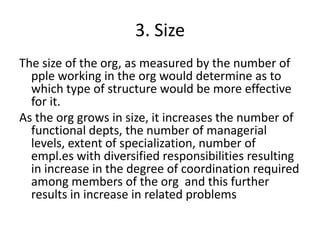This document discusses elements of organizational structure. It defines organizational structure as referring to the division of labor, patterns of coordination, communication, workflow, and formal power that direct organizational activities. The four basic elements of organizational structure are span of control, centralization, formalization, and departmentalization. Organizational structure is shaped by factors like the environment, technology, size of the organization, and its strategy. The structure facilitates management action, encourages efficiency, communication, optimal use of resources, and job satisfaction.
















